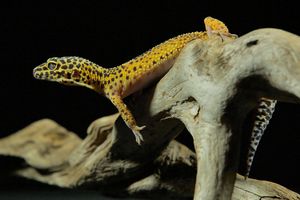
Cryptosporidium varanii is a species of Cryptosporidium that mostly infects the small intestinal mucosa, rarely in gastric mucosa, large intestine, and cloaca of reptiles. It acts by damaging the cells that line the intestines, predisposing to other bacterial and intestinal parasite infections. It is transmitted via fecal-oral route or direct contact. Many infected can be subclinical, spreading the infection through collections. Young, high-density reptile collections are at the highest risk. The zoonotic potential is low. The organism is intermittently shed in the feces. Carnivorous lizards can have oocysts in the feces as an incidental finding due to the presence of it in the prey items. DNA PCR testing can be used to differentiate C. varanii from C. muris and C. parvum.
Reptiles infected with Cryptosporidium exhibit nonspecific signs including loss of muscle mass, loss of appetite, lethargy, weakness, and diarrhea. Cloacal prolapse and bladder infections can both occur as a complication with Cryptosporidium sp. Infection.
Similar symptoms can be seen with other gastrointestinal parasite infestations such as flagellates, coccidia, and other intestinal parasites. They may also be seen with tumors of the digestive system, poor diet, inadequate husbandry, and metabolic disease.
Diagnostic testing should start with fecal parasite testing. However, it is not uncommon to miss this parasite on stand fecal testing. A special stain called a Modified Ziehl-Neelsen stain can be used to help detect the organism that will show up as red. Immunofluorescence antibody tests (IFAT) may also help identify the organism. PCR DNA probes for Cryptosporidium is probably the most reliable test for this parasite. However, a negative test does not mean the animal does not have Cryptosporidium sp. Definitive diagnosis requires intestinal biopsy. Bloodwork should also be used to evaluate for systemic disease.
Positive animals should be completely isolation from other animals in permanent quarantine. Use paper towels as substrate to allow for ease of cleaning. The burden of Cryptosporidium was found to be reduced after treatment using paromomycin but may not clear the organism from the body leaving them as carriers. Other medications have been utilized in many species with varying success. Supportive care with fluid therapy and assist feeding is recommended for debilitated animals.
The key to prevention is to quarantine all new reptiles at least 30 days and repeat fecal analysis for all new additions to a collection. Good environmental hygiene is also key. Physical removal of all fecal material and contaminated substrate will help decrease the amount of infective material in the environment. Disinfection with ammonia (5%) and formalin (10%) with a contact time of 18 hours or potentiated hydrogen peroxide-based cleaners such as Rescue at a 1:16 dilution with a contact time 10-15 minutes.
The prognosis for asymptomatic carriers is good to fair as long as they remain asymptomatic. However, they need to remain permanently in quarantine. Debilitated animals have a guarded to poor prognosis.
For clinically ill patients, frequent recheck examinations and changes to treatment based on clinical symptoms.
Copyright © All Rights Reserved
